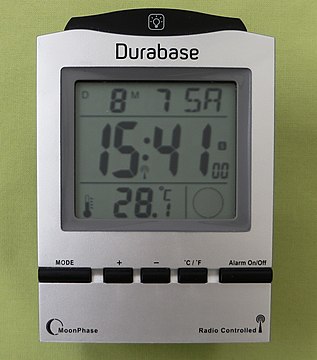Digital clock

A digital clock is a clock showing the time by numbers change directly displays . It differs from an analog clock , which usually uses moving hands on a fixed dial to display the time . The way in which the time is measured is irrelevant - it can be done with a digital clock using analog technology or with an analog clock using digital technology .

The first digital clocks existed as early as the 19th century, for example in the stage portal of the Dresden Semperoper with a display in the duodecimal system (twelve hours in Roman numerals and twelve five-minute steps in the European variant of the Indo-Arabic numerals ). The digital display above the astronomical clock face on the clock tower (Torre dell'Orologio) in St. Mark's Square in Venice works in a similar way .
Types of display
Nowadays, the digits are usually displayed on LC displays . In the 1970s , LED displays were initially common, but because of their high power consumption, battery-operated watches (especially wristwatches ) only light up at the push of a button. From around 1974 LCD displays with the twisted nematic (TN) electro-optical effect followed. Other display variants that are hardly used today are drop sheets (known from the train station / airport display boards ), discs or rollers with printed numbers (e.g. in the km display on cars ) and Nixie tubes . In another variant, the drive is carried out by a synchronous motor that moves mechanical screens that are arranged in the form of a seven-segment display and are illuminated by an incandescent lamp . These types of display can also be found on older electric alarm clocks . Seven-segment displays are predominantly used to display the numbers, sometimes also matrix displays .
Types of representation
The time is usually displayed on a digital clock in one of the following variants:
-
00:00:00 to 23:59:59 ( → 24-hour counting )
Stunden:Minuten:Sekunden -
00:00 to 23:59 (
Stunden:Minuten, 24-hour count) -
00:01 to 24:00 (
Stunden:Minuten, 24-hour count) -
00:00 AM to 11:59 PM (
Stunden:Minutenmorning ( AM ) andStunden:Minutenafternoon ( PM )) → 2-times 12-hour counting -
0.00h to 23.99h (
Stunden, Dezimalminuten. 1:45 gives, for example, 1.75 hours) - @ 000 - @ 999 (a less common variant in Swatch Internet Time )
Compared to the representation of the analog clock, the digital clock has the advantage that the displays of z. B. two o'clock at night (02:00) and two o'clock in the day (14:00) are distinguishable. In addition, (mostly) no moving parts are required. The disadvantage is that the display has to be read consciously , whereas with an analog clock, a cursory glance provides sufficient basic information. The exact time can, however, be read off faster and more precisely with a digital clock.
Digital wristwatches almost exclusively use oscillating crystals as a clock- setting element for digital electronics, so that the term quartz watch has often been equated with the term digital watch. In the meantime (after 2000 ), however, the number of quartz-controlled digital and analog clocks has been balanced.
Picture gallery
- Different versions of digital clocks
Digital clock driven by a synchronous motor
Casio LCD digital wristwatch with backlight at the touch of a button.
Alarm clock with liquid crystal digital display. In addition to the radio-synchronized time, date and moon phase display, also temperature information.
Web links
- Inventors John Bergey and Dick Walton
- The History of the Digital Watch
- English site on the subject, mostly LCD clocks



